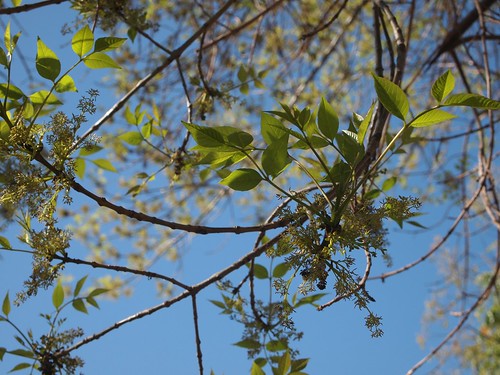Garden Inventory is a series where I begin an inventory of all the plants and trees in my garden. Along with some of my own pictures, I will link to various sources of information about each plant and tree so we can learn a little more together.
I would also like to highlight your special plants and tress. Pass along your favorite plants in the comments and I will use them for future Garden Inventory posts. — Douglas
Garden Inventory: Ash (Fraxinus)
“Fraxinus (pron.: /ˈfræksɨnəs/)[2] is a genus of flowering plants in the olive and lilac family, Oleaceae. It contains 45-65 species of usually medium to large trees, mostly deciduous though a few subtropical species are evergreen. The tree’s common English name, ash, goes back to the Old English æsc, while the generic name originated in Latin. Both words also meant “spear” in their respective languages.[3] The leaves are opposite (rarely in whorls of three), and mostly pinnately compound, simple in a few species. The seeds, popularly known as keys or helicopter seeds, are a type of fruit known as a samara. Rowans or Mountain Ashes are unrelated to true ashes and belong to the Genus Sorbus though the leaves and buds are superficially similar.” — http://en.wikipedia.org/wiki/Fraxinus
I never knew there were so many different types of Ash trees, so I have no idea what particular variety this one is. Now that I know it is a Fraxinus, I will have to go through some “keying” and try to figure out its particulars. Ash trees grow all over Europe and most of the United States and Canada, with different varieties being prominent in different areas.
In the photos below, I have highlighted the bark, the general growing habit, trunk shape and size and, due to lucky timing, both the leaves and the flowers of the tree, which is just now coming back into leaf after a short period of deciduous dormancy. Maybe someone more knowledge about trees than myself can help me identify it.
The tree has a few issues. It is multi-trunked, which I don’t think is normal for an Ash. It probably means it was damaged sometime in its youth. When taking photos I noticed that this large crotch is collecting a good amount of rain water and a huge colony of ants. I hope it isn’t causing rot, but I will need to contact my tree experts online and see what I might do to prevent any damage in the future.
I love how I always learn a it about my plants when doing these inventory posts. I had no idea that Ash was related to olives and lilacs. One of the few facts I knew about Ash was that it was the traditional wood for baseball bats here in the US Major Leagues.
Emerald Ash Borer has been attacking Ash trees throughout the East Coast of the US and will probably spread across the continent eventually. There are a variety of treatments available. Find out more about Emerald Ash Borer via Wikipedia.
Photos of Ash (Fraxinus) of unknown variety with closeups of leaves flowers, growing habit, trunk and bark
More information on Ash (Fraxinux):
- Fraxinus at Wikipedia
- Emerald Ash Borer at Wikipedia
- Ash Tree Identification Guide from Michigan State University
Previously on Garden Inventory:












